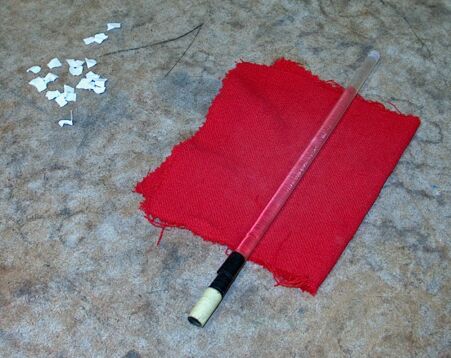

Rub the plastic rod (polyethylene terephthalate, glycol modified, or PETG) with the cloth. Hold the rod close to the pile of paper bits. The bits will be attracted to the rod.
This demonstration involves two phenomena, triboelectricity – the transfer of charge from one object to another by friction, and polarization by induction – the redistribution of charge on an object by placing it near a charged object, that are illustrated by subsequent demonstrations. (See, for example, 56.06 -- Electrostatically charged rods, and 56.18 -- Induced charging of metal spheres.) It comes first, however, for historical reasons. In 600 B.C.E., Thales of Miletus found that when he rubbed amber with wool, the amber then attracted bits of straw. We now know that this ability arises from the fact that after one rubs amber with wool, the amber becomes electrically charged (and so does the wool, with opposite charge). The words “electric” and “electrical” come from the Greek elektron, which means “amber.”
The photograph above shows a plastic rod and a wool cloth. Rubbing the plastic rod with the wool cloth charges the rod negative. The bits of paper are electrically neutral, but when you bring the rod close to them, even though paper is not a conductor, that is, the charges within it are not free to move about as a current, the negative charges have enough mobility that they are repelled by the rod. This leaves a net positive charge on the parts of the paper bits nearest the rod, and the rod attracts the paper bits, which fly up and stick to the rod. This is the same mechanism by which you can charge a balloon by rubbing it against your hair, and then place it on a wall and have it stick there. It is also the cause of “static cling” among items in a clothes dryer.
Also available is a glass rod with a silk cloth. Rubbing the glass with the silk charges the glass positive, and the glass rod thus charged attracts the paper bits in the same way that the plastic rod does. As noted above, this phenomenon is called triboelectricity, and it depends on the varying affinities that different materials have for electrons. When you rub two materials together, the material that has the stronger affinity for electrons pulls them from the other material. (Merely touching the two materials together is sufficient to transfer at least some charge, but rubbing greatly improves the contact.) This leaves a net negative charge on the material that has gained electrons, and a net positive charge on the material that has lost electrons. One can rank materials in order of their tendency to pull electrons from other materials (or deposit them onto other materials), in a triboelectric series. For an article in which the authors construct several such series, see the following paper (from any UCSB-connected computer): A.F Diaz and R.M. Felix-Navarro, Journal of Electrostatics, 62(4) (2004) 277-290.
References:
1) Halliday, David and Resnick, Robert. Physics, Part Two, Third Edition (New York: John Wiley and Sons, 1978), p. 565.
2) Young, Hugh D. and Geller, Robert M. Sears and Zemansky’s College Physics, 8th edition (San Francisco: Addison Wesley, 2007), p. 545.